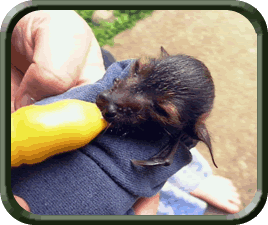
Friends
of the Far North Flying Foxes Inc
What
Happened at the
Whiteing Road Colony During 1995
(from FFNFF Newsletter, Edition 3, October 1996)
The Whiteing Road colony was checked daily from early October till 20 Deceniber 1995 by Alan and Cay Williamson, Ann and Bruce Johnson, helped by Elizabeth Lovett, David Slatter on weekends, as well as a few other visitors. The data on 226 tick paralysed spectacled bats was recorded. Weight and forearm data were sent to Dr. Chris Tidemann at the Australian National University.
Survival rate
and treatment
176 adult bats recovered giving an overall survival rate of 78%. Some
of these bats died for reasons other than tick intoxication, such as internal
maggot damage or injuries incurred on impact with the ground when they
fell. Quantities of tick anti-venene given varied between 2 to 4.5 ml
per bat. Tick paralysed bats not collected were consumed by Canis familiaris
(dingoes) as evidenced by pairs of bat wings found on the forest floor.
Peak tick infestation occurred between 16 and 24 November, with up to
14 cases per day collected.
 Mums
and hubs
Mums
and hubs
80% of collected bats were female. 134 females were lactating. 98 females
had a baby attached. 36 lactating females had lost their babies. 50 baby
bats were reunited with their recovered mothers and 130 baby spectacled
bats were fostered out. 11% of the female bats were juvenile. The percentage
of females collected increased with time through the tick season.
Males, fly strike
and survival rates
16% of the male bats were juvenile. 27% of the bats suffered fly strike
and 51 % of bats that died were fly blown. 35% of morning bats were blown.
20% of recovered bats had suffered fly strike. 42% of bats were collected
in the morning and 60% of the bats that died were collected in the morning.
The survival rate of morning bats was 69% and afternoon bats 85%. The
survival rate of the first 50 evening bats collected was 91%.
Tick statistics
The average tick body length was 4.7 mm. (A fully engorged paralysis tick
is 13 mm long). 81 % of ticks were less than 6 mm long. 4% of bats had
more than 1 tick.
Survival rate was improved by a few percent when:-
1. the tick anti-toxin was diluted 50% with saline (0.9% NaCl).
2. the tick body was sliced open with sharp tweezer, the gut contents squeezed out and the tick hypostome left in situ. As against, poisoning the tick in situ.
3. the tick size was 6 mm or larger.
Other figures are available on request.
